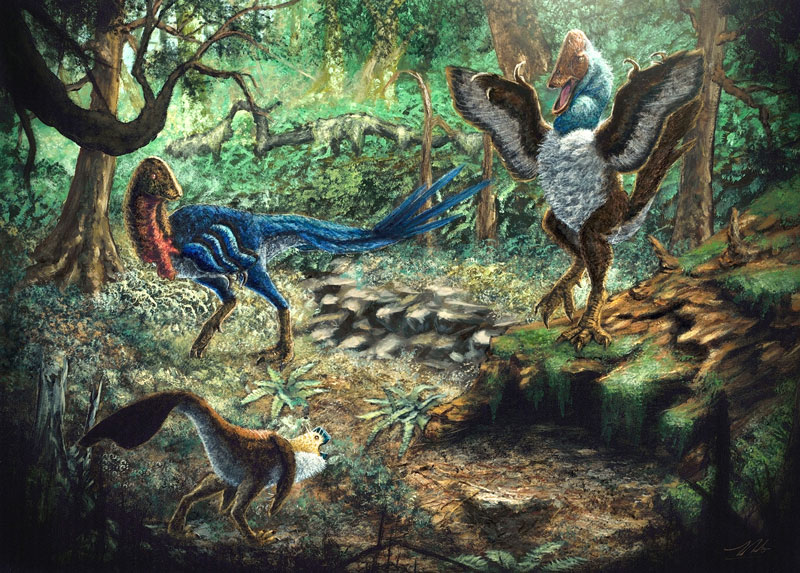MAR
LCCC instructor co-authors paper identifying new dinosaur species
 CHEYENNE, Wyoming – An adjunct instructor at Laramie County Community College’s Albany
County Campus co-authored a recently published scientific paper changing the way we
think about dinosaurs and their twilight years on Earth.
CHEYENNE, Wyoming – An adjunct instructor at Laramie County Community College’s Albany
County Campus co-authored a recently published scientific paper changing the way we
think about dinosaurs and their twilight years on Earth.
A newly discovered dinosaur species, Eoneophron infernalis, has been identified in the Hell Creek Formation, sharing its habitat with the T. rex and other iconic dinosaurs in what we now know as South Dakota. The turkey-sized, parrot-like dinosaur adds to the diversity of caenagnathids, a group of beaked dinosaurs. The discovery, based on a detailed examination of its hindlimb, offers insights into the diverse ecosystems that existed just before the mass extinction event 66 million years ago. These findings challenge previous assumptions about dinosaur diversity and survival strategies during the late Cretaceous period.
Eoneophron infernalis lived in North America just before the mass extinction event where an asteroid impacted the Earth. This species, standing about 3 feet tall and weighing between 130 and 216 pounds, contributes to scientists’ understanding of Oviraptorosaurs, bird-like dinosaurs. The discovery, described in the journal PLOS ONE, challenges the notion of decreasing dinosaur diversity toward the Cretaceous period's end, indicating a more complex pre-extinction ecosystem. Fossils found in the Hell Creek Formation suggest this species shared features with its cousin, Anzu Wylie, including a toothless beak and feathered wings.
Jade Simon, a geology instructor at LCCC, said previous research in the field suggested that dinosaurs were declining in diversity in the years before the extinction event that changed Earth’s course, meaning the asteroid might have been a death blow to an already troubled species. Recently, however, she said research done by her and others shows that there was more diversity among dinosaur species than previously understood.
“It’s sort of flipping that narrative that dinosaurs were on their way out on its head,” Simon said. “Dinosaurs, in general, were extremely successful for over 100 million years. So, who knows what would have happened if not for the asteroid impact.”
Simon specializes in studying theropod dinosaurs, with her Ph.D. research looking at species diversity and growth. Her work at the University of Toronto and Royal Ontario Museum took her looking at the Hell Creek Formation in South Dakota, North Dakota and Montana and the Horseshoe Canyon Formation in Alberta. In those studies, Simon and others discovered a significant number of new species, challenging the idea that dinosaurs were broadly in decline toward the end of the Cretaceous period.
“Now, after looking at several different specimens and studying their histology — including examining the bone tissues under the microscope and looking at their anatomy — we've been able to figure out we have several different species and that we're looking at a pretty diverse and flourishing group,” she said.
Throughout the last year, Simon worked with her co-authors, discussing her research and helping the lead author to relate this specimen in the proper context.
LCCC students in Simon’s courses were excited by the news, she said, which helps convey the interesting elements of science. When students have the information they’re learning in class connected to big-picture implications, Simon said they can thrive.
“It helps them to connect with the material better and remember it by putting it in an exciting context, rather than just having them try to memorize a lot of information that just seems random,” Simon said.
Simon is a native of West Virginia whose interest in rocks and animals led her to study science. She completed her undergraduate studies at West Virginia University before heading to Montana State University for her master’s studies. Currently, Simon is working toward completing her Ph.D. in ecology and evolutionary biology.
Wyoming, Simon said, is a great state for pursuing her interests because of its rich paleontological record. As for her future, she hopes to participate in more ground-breaking research and continue teaching.
“I would love to pursue teaching full-time and being able to invest in that because it makes me very happy — it’s very fulfilling,” Simon said. “I also love being able to use my research in my teaching.”
Articles about Simon’s research can be seen in Newsweek, the Smithsonian and the Oklahoman. Go to lccc.wy.edu/STEM for more information about science programs at the college.
